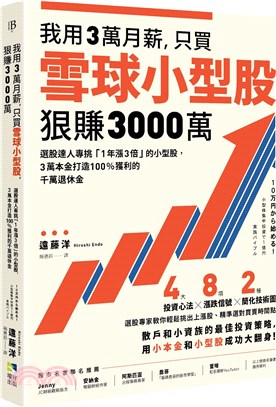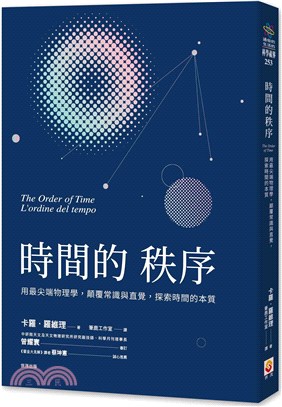POSITIVE ALPHA GENERATION - DESIGNING SOUND INVESTMENT PROCESSES
商品資訊
相關商品
商品簡介
作者簡介
目次
商品簡介
Diderich describes tools and techniques, which can be used to develop quantitative models for actively managing investment products, and focuses on how theoretical models can and should be used in practice. He describes the interaction between different elements of an investment process's value chain in a single and consistent framework. A key focus is placed on illustrating the theory with real world examples. At the end of the book the reader will be capable of designing or enhancing an investment process for an investment or portfolio managers products from start to finish.
* Increased pressure to add value through investments makes this a hot topic in the investment world
* Combined theoretical and practical approach makes this book appealing to a wide audience of quants and investors
* The only book to show how to design and implement quantitative models for gaining positive alpha
* Increased pressure to add value through investments makes this a hot topic in the investment world
* Combined theoretical and practical approach makes this book appealing to a wide audience of quants and investors
* The only book to show how to design and implement quantitative models for gaining positive alpha
作者簡介
Dr. Claude Diderich is a Manager at the Financial Services Practice of Deloitte Consulting in Zurich, Switzerland. Previously he was head of investment process and portfolio analytics at a major Swiss private bank, where he was developing innovative investment solutions for institutional and private investors with a focus on the underlying alpha generating investment process. Previously Dr. Diderich worked at Credit Suisse Asset Management where he designed and implemented different successful asset allocation and fixed income investment products and the associated investment processes. Dr. Diderich holds a doctor ès sciences and a masters in computer science engineering from the Swiss Federal Institute of Technology in Lausanne. He is a certified EFFAS Financial Analyst and Portfolio Manager, FRM certified, and a certified New Product Development Professional.
目次
Preface.
1. Introduction.
1.1 Characteristics of a successful investment process.
1.2 Challenges to be solved.
1.3 Approach taken in this book.
1.4 Structure of the book.
1.5 Notation.
PART I: THE VALUE CHAIN OF ACTIVE INVESTMENT MANAGEMENT.
2. Key Success Factors for Generating Positive Alpha Positive Alpha.
2.1 Key success factors.
2.2 Decomposing return.
2.3 Defining risk.
2.4 The information ratio.
2.5 Fundamental law of active management.
2.6 The process of developing an investment process.
3. The Investment Management Value Chain.
3.1 The value chain components.
3.2 Designing a value chain based investment process.
3.3 Implementing the value chain approach.
3.4 Investment Processes Example.
PART II: FORECASTING MARKETS.
4. Judgmental Approaches for Forecasting Markets Markets.
4.1 Market efficiencies.
4.2 Understanding asset returns.
4.3 Forecasting asset returns.
4.4 Example.
5. Quantitative Approaches for Forecasting Markets for Forecasting Markets.
5.1 Building a quantitative forecasting model.
5.2 Defining the model structure.
5.3 Handling data in parameter estimation.
5.4 Testing the model.
5.5 Mitigating model risk.
5.6 Example.
6. Taking Investment Decisions.
6.1 Understanding the theory of decision making.
6.2 Building a decision making process.
6.3 Example.
PART III: RISK MEASUREMENT AND MANAGEMENT.
7. Modeling Risk.
7.1 The different dimensions of risk.
7.2 Risk management from an investor's perspective.
7.3 Risk from an investment manager's perspective.
7.4 The theory behind modeling market risk.
7.5 The process of developing a risk model.
7.6 Information risk.
8. Volatility as a Risk Measure.
8.1 The volatility risk model in theory.
8.2 Selecting data for parameter estimation.
8.3 Estimating the risk model's parameters.
8.4 Decomposing volatility.
8.5 Additional pitfalls.
8.6 Testing risk models.
9. Alternative Risk Measures.
9.1 Framework defining risk.
9.2 Alternative return distributions.
9.3 Exposure based risk models.
9.4 Nonparametric risk models.
9.5 Handling assets with nonlinear payoffs.
9.6 Credit risk models.
PART IV: PORTFOLIO CONSTRUCTION.
10. Single Period Mean-Variance Based Portfolio Construction Portfolio Construction.
10.1 Developing a modular portfolio construction process.
10.2 The mean-variance framework.
10.3 The Markowitz mean-variance model.
10.4 Alternative mean-variance based models.
10.5 Models with alternative risk definitions.
10.6 Information risk based models.
10.7 Selecting a portfolio construction approach.
11. Single Period Factor Model Based Portfolio Construction Portfolio Construction.
11.1 Factor models and their relation to risk.
11.2 Portfolio construction exploiting idiosyncratic risk.
11.3 Pure factor model exposure based portfolio construction.
11.4 Factor sensitivity based portfolio construction.
11.5 Combining systematic and specific risk based portfolio construction algorithms.
12. Dynamic Portfolio Construction.
12.1 Dynamic portfolio construction models.
12.2 Dynamic portfolio construction algorithms.
PART V PORTFOLIO IMPLEMENTATION.
13. Transaction Costs, Liquidity and Trading.
13.1 Understanding transaction costs and market liquidity.
13.2 The action and context of trading.
13.3 Implementation and trading as a module of an investment process value chain.
13.4 Equity asset allocation trading approach example.
14. Using Derivatives.
14.1 Derivative Instrument characteristics.
14.2 Using derivatives to implement an investment strategy.
14.3 Example.
PART VI: INVESTMENT PRODUCTS AND SOLUTIONS.
15. Benchmark Oriented Solutions Benchmark Oriented Solutions.
15.1 benchmarks.
15.2 Passive benchmark oriented investment solutions.
15.3 Active benchmark oriented investment solutions.
15.4 Core-satellite solutions.
15.5 A sample benchmark oriented solution.
16. Absolute Positive Return Solutions.
16.1 What absolute positive return can mean.
16.2 Satisfying the investor's expectations.
16.3 The relationship between risk and return.
16.4 Long-only forecasting based solutions.
16.5 The portable alpha approach.
16.6 combining APR and benchmark oriented solutions.
17. Capital Protection and Preservation Approaches Approaches.
17.1 The investor's utility function.
17.2 Portfolio insurance investment processes.
17.3 Comparing different PIIPs.
17.4 Managing risk.
17.5 Designing a client specific capital protection solution.
18. Hedge Funds Hedge Funds.
18.1 Success factors of hedge funds.
18.2 Exploitable alpha generating sources.
18.3 Issues specific to hedge funds.
18.4 Developing a hedge fund investment process.
18.5 Hedge funds as an asset class.
19. Liability Driven Investing.
19.1 The concept of liability driven investing.
19.2 Portfolio construction in a Liability driven investment context.
19.3 Liability driven investment solutions.
19.4 A process for determining an LDI solution.
PART VII: QUALITY MANAGEMENT.
20. Investment Performance Measurement.
20.1 Performance measurement dimensions.
20.2 Setting up a performance measurement framework.
20.3 Basics of performance measurement.
20.4 Performance attribution.
20.5 Performance contribution.
20.6 The process behind the process.
20.7 Practical considerations in performance measurement.
20.8 Examples of performance measurement frameworks.
Bibliography.
Index.
1. Introduction.
1.1 Characteristics of a successful investment process.
1.2 Challenges to be solved.
1.3 Approach taken in this book.
1.4 Structure of the book.
1.5 Notation.
PART I: THE VALUE CHAIN OF ACTIVE INVESTMENT MANAGEMENT.
2. Key Success Factors for Generating Positive Alpha Positive Alpha.
2.1 Key success factors.
2.2 Decomposing return.
2.3 Defining risk.
2.4 The information ratio.
2.5 Fundamental law of active management.
2.6 The process of developing an investment process.
3. The Investment Management Value Chain.
3.1 The value chain components.
3.2 Designing a value chain based investment process.
3.3 Implementing the value chain approach.
3.4 Investment Processes Example.
PART II: FORECASTING MARKETS.
4. Judgmental Approaches for Forecasting Markets Markets.
4.1 Market efficiencies.
4.2 Understanding asset returns.
4.3 Forecasting asset returns.
4.4 Example.
5. Quantitative Approaches for Forecasting Markets for Forecasting Markets.
5.1 Building a quantitative forecasting model.
5.2 Defining the model structure.
5.3 Handling data in parameter estimation.
5.4 Testing the model.
5.5 Mitigating model risk.
5.6 Example.
6. Taking Investment Decisions.
6.1 Understanding the theory of decision making.
6.2 Building a decision making process.
6.3 Example.
PART III: RISK MEASUREMENT AND MANAGEMENT.
7. Modeling Risk.
7.1 The different dimensions of risk.
7.2 Risk management from an investor's perspective.
7.3 Risk from an investment manager's perspective.
7.4 The theory behind modeling market risk.
7.5 The process of developing a risk model.
7.6 Information risk.
8. Volatility as a Risk Measure.
8.1 The volatility risk model in theory.
8.2 Selecting data for parameter estimation.
8.3 Estimating the risk model's parameters.
8.4 Decomposing volatility.
8.5 Additional pitfalls.
8.6 Testing risk models.
9. Alternative Risk Measures.
9.1 Framework defining risk.
9.2 Alternative return distributions.
9.3 Exposure based risk models.
9.4 Nonparametric risk models.
9.5 Handling assets with nonlinear payoffs.
9.6 Credit risk models.
PART IV: PORTFOLIO CONSTRUCTION.
10. Single Period Mean-Variance Based Portfolio Construction Portfolio Construction.
10.1 Developing a modular portfolio construction process.
10.2 The mean-variance framework.
10.3 The Markowitz mean-variance model.
10.4 Alternative mean-variance based models.
10.5 Models with alternative risk definitions.
10.6 Information risk based models.
10.7 Selecting a portfolio construction approach.
11. Single Period Factor Model Based Portfolio Construction Portfolio Construction.
11.1 Factor models and their relation to risk.
11.2 Portfolio construction exploiting idiosyncratic risk.
11.3 Pure factor model exposure based portfolio construction.
11.4 Factor sensitivity based portfolio construction.
11.5 Combining systematic and specific risk based portfolio construction algorithms.
12. Dynamic Portfolio Construction.
12.1 Dynamic portfolio construction models.
12.2 Dynamic portfolio construction algorithms.
PART V PORTFOLIO IMPLEMENTATION.
13. Transaction Costs, Liquidity and Trading.
13.1 Understanding transaction costs and market liquidity.
13.2 The action and context of trading.
13.3 Implementation and trading as a module of an investment process value chain.
13.4 Equity asset allocation trading approach example.
14. Using Derivatives.
14.1 Derivative Instrument characteristics.
14.2 Using derivatives to implement an investment strategy.
14.3 Example.
PART VI: INVESTMENT PRODUCTS AND SOLUTIONS.
15. Benchmark Oriented Solutions Benchmark Oriented Solutions.
15.1 benchmarks.
15.2 Passive benchmark oriented investment solutions.
15.3 Active benchmark oriented investment solutions.
15.4 Core-satellite solutions.
15.5 A sample benchmark oriented solution.
16. Absolute Positive Return Solutions.
16.1 What absolute positive return can mean.
16.2 Satisfying the investor's expectations.
16.3 The relationship between risk and return.
16.4 Long-only forecasting based solutions.
16.5 The portable alpha approach.
16.6 combining APR and benchmark oriented solutions.
17. Capital Protection and Preservation Approaches Approaches.
17.1 The investor's utility function.
17.2 Portfolio insurance investment processes.
17.3 Comparing different PIIPs.
17.4 Managing risk.
17.5 Designing a client specific capital protection solution.
18. Hedge Funds Hedge Funds.
18.1 Success factors of hedge funds.
18.2 Exploitable alpha generating sources.
18.3 Issues specific to hedge funds.
18.4 Developing a hedge fund investment process.
18.5 Hedge funds as an asset class.
19. Liability Driven Investing.
19.1 The concept of liability driven investing.
19.2 Portfolio construction in a Liability driven investment context.
19.3 Liability driven investment solutions.
19.4 A process for determining an LDI solution.
PART VII: QUALITY MANAGEMENT.
20. Investment Performance Measurement.
20.1 Performance measurement dimensions.
20.2 Setting up a performance measurement framework.
20.3 Basics of performance measurement.
20.4 Performance attribution.
20.5 Performance contribution.
20.6 The process behind the process.
20.7 Practical considerations in performance measurement.
20.8 Examples of performance measurement frameworks.
Bibliography.
Index.
主題書展
更多
主題書展
更多書展本週66折
您曾經瀏覽過的商品
購物須知
外文書商品之書封,為出版社提供之樣本。實際出貨商品,以出版社所提供之現有版本為主。部份書籍,因出版社供應狀況特殊,匯率將依實際狀況做調整。
無庫存之商品,在您完成訂單程序之後,將以空運的方式為你下單調貨。為了縮短等待的時間,建議您將外文書與其他商品分開下單,以獲得最快的取貨速度,平均調貨時間為1~2個月。
為了保護您的權益,「三民網路書店」提供會員七日商品鑑賞期(收到商品為起始日)。
若要辦理退貨,請在商品鑑賞期內寄回,且商品必須是全新狀態與完整包裝(商品、附件、發票、隨貨贈品等)否則恕不接受退貨。
























